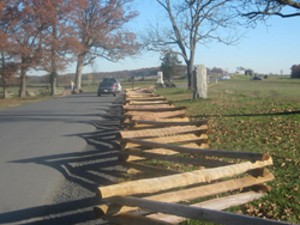 The snake rail fence originated from hand-split logs used to construct fences. If you’re looking for the historical and rustic look of Early America, then the snake rail fence is just right. Logs from traditional wood fencing were not tapered or sewn but cut with a log-splitting machine, giving them an authentic hand-split look. Snake rail fences are also called Virginia fences because they were most often used in properties located in Virginia and West Virginia.
The snake rail fence originated from hand-split logs used to construct fences. If you’re looking for the historical and rustic look of Early America, then the snake rail fence is just right. Logs from traditional wood fencing were not tapered or sewn but cut with a log-splitting machine, giving them an authentic hand-split look. Snake rail fences are also called Virginia fences because they were most often used in properties located in Virginia and West Virginia.
Hand Split & Snake Rail Fence History
A split-rail fence or log fence is a type of fence constructed out of timber logs, usually split lengthwise into rails and typically used for agricultural or decorative fencing. Such fences require much more timber than other types of fences, and so are generally only common in areas where wood is abundant. However, they are very simple in their construction, and can be assembled with few tools even on hard or rocky ground. They also can be built without using any nails or other hardware; such hardware was often scarce in frontier areas. They are particularly popular in very rocky areas where post hole digging is almost impossible. They can even be partially or wholly disassembled if the fence needs to be moved or the wood becomes more useful for other purposes. During the American Civil War, these split rail fences were a major source of firewood for both the Union and Confederate armies.
Split rail fences were made of easy to split, rot-resistant wood. Traditionally American chestnut was the timber of choice until chestnut blight eliminated this tree. Currently, most split rails are made from cedar. Whether of chestnut or cedar, these logs were cut to a length of 10 to 12 feet (3.0 to 3.7 m) and split down the length of the log. Each half was then split into quarters, then eighths and so on until the rails were of a usable size. A log may produce from four rails from an 8-inch (20 cm) log to over a dozen from larger logs. The rails are stacked on top of one another. Most split rail fences have the rails stacked in an interlocking zigzags fashion that is self-supporting, easy to create, easy to repair, and easy to disassemble.
Some timber fences have the rails stacked directly on top of each other and secured with double fence posts (one on either side of the rails). This made a more permanent and compact fence but remained easy to repair.
The distance between either the zigs or the zags is generally 16.5 feet (5 m) or one rod. The area of a field can therefore be calculated by counting zigs or zags along the side and end of the field: one hundred sixty square rods is 1-acre (0.40 ha).


